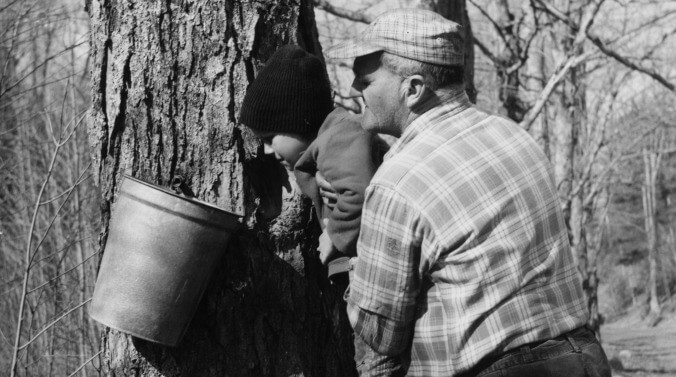Canada’s heist of the century involved $18.7 million worth of maple syrup

We explore some of Wikipedia’s oddities in our 6,271,621-week series, Wiki Wormhole.
This week’s entry: The Great Canadian Maple Syrup Heist
What it’s about: The most Canadian crime-of-the-century possible. Across several months in 2011 to 2012, a shadowy network of criminals pulled off an unthinkable heist, stealing $18.7 million worth of maple syrup from a storage facility in Quebec.
Biggest controversy: That Rick Moranis came out of retirement to do a stupid cellphone commercial and not a movie where he puts an Oceans Eleven-style gang of very polite master criminals to pilfer Canada’s greatest liquid assets.
Strangest fact: The syrup thieves and Walter White used the same methods nearly simultaneously. In 2012 Breaking Bad episode “Dead Freight,” Walt and Jesse siphon methylamine from a train’s tanker car, replacing the chemical with water so the weight will be unchanged. The syrup thieves did exactly the same thing with 600-pound barrels of syrup, except they started in 2011, well ahead of Walt and Jesse’s scheme, but the Breaking Bad writers wrote the episode well before the syrup heist was exposed. (Eventually, the syrup thieves got lazy and simply emptied the barrels; as it turned out that the syrup was only inspected once a year, so their crime went unnoticed until the end of the year.)
Thing we were happiest to learn: Fear not, pancake lovers, Canada has a strategic syrup reserve. Back in 1966, several of Quebec’s leading syrup producers decided to coordinate their marketing efforts, forming the Federation Of Quebec Maple Syrup Producers (FPAQ, which abbreviates the French translation). FPAQ controls 94% of Canada’s maple syrup (and therefore 77% of the world’s supply), and has been likened to a drug cartel. They maintain a permanent supply of liquid gold, the International Strategic Reserve, stored in warehouses across several Quebecois small towns. It was from one such warehouse that our thieves drained 9,571 barrels of syrup.
Thing we were unhappiest to learn: The article doesn’t give nearly enough detail on this black market syrup operation. Once the syrup had been drained, it was transported by truck to, “a remote sugar shack,” and then sold in small batches to “legitimate syrup distributors,” in Vermont and New Brunswick who were unaware of the syrup’s ill-gotten origins. But it’s unclear what a remote sugar shack looks like, or how the thieves were caught. Over three days in December 2012, seventeen men were arrested, including ringleader Richard Vallières and his father Raymond. But Wikipedia gives no clue as to how they were identified or caught, and cryptically says Raymond Vallières was “convicted of possession,” although we can’t imagine possession of maple syrup in any amount is a crime. Richard Vallières was eventually sentenced to eight years in prison in 2017. Six years would be added to his sentence if he failed to pay a fine of $9.4 million, but it’s not clear which of those happened.
Best link to elsewhere on Wikipedia: Maple syrup has a surprisingly mysterious history. “The chemistry responsible” for its unique flavor “is not fully understood,” and neither are its origins. North Americans were tapping maple trees and boiling sap to make syrup and sugar long before the arrival of Europeans, but neither oral tradition nor archaeological evidence provides any clue as how how the practice originated, or who decided tree sap might taste good. But the Algonquians are credited with a method of tapping trees still used today, making a v-shaped incision in the trunk, and using a funnel to collect the sap.
The maple syrup Wikipedia page also details the economics and classification of syrup, going into great detail about the grading system (based around color). Maple sugar and cane sugar also have a surprisingly fraught rivalry; before the Civil War, maple sugar was the choice of abolitionists, as cane sugar was produced by slave labor; after the war, cane sugar came to dominate the market and maple producers shifted their focus to syrup. (Wikipedia also notes that anything labeled “pancake syrup” is an appalling concoction of high fructose corn syrup and artificial maple flavoring.)
Further Down the Wormhole: Another competitor to maple syrup (also, unfortunately, largely produced by slave labor pre-Emancipation) is molasses. A syrup made from sugarcane or sugar beets, molasses is primarily used as a sweetener or baking ingredient in modern times, but before the 20th century, it was used as an ingredient in making rum and beer. Blackstrap molasses, made by boiling down molasses three times instead of just once, is a more bitter concoction used in ethanol, cattle feed, and fertilizer. (The 1951 song “Black Strap Molasses,” sung by Groucho Marx, Jane Wyman, Danny Kaye, and Jimmy Durante, spoofed the syrup’s exaggerated health benefits, claiming it, “makes you live so long you wish you were dead.”) Shockingly, molasses actually did turn deadly once, in an absurd tragedy we can’t believe we haven’t covered before now. We’ll recount the Great Boston Molasses Flood next week.